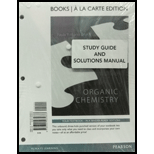
Interpretation:
- The products of the given Diels-Alder reaction has to be predicted.
Concept Introduction:
Diels-Alder reaction:
A conjugated diene reacts with a compound containing a carbon-carbon double bond. It is a cycloaddition reaction, where two reactants form a cyclic product.
Conformation of Diene:
S-Cis Conformer: The double bonds are cis about the single bond (s stands for single), in an s-cis conformer.
S-trans Conformer:The double bonds are trans- about the single bond (s stands for single) in an s-trans conformer.
Condition for Diels-Alder reaction:
The conjugate diene must be in an s-cis conformation because when it is in an S-trans conformation, C-1 and C-4 are too far apart to react with the dienophile in a concerted reaction.
Rule: The stabilities of carbocation are,
Want to see the full answer?
Check out a sample textbook solution
Chapter 8 Solutions
Study Guide And Student Solutions Manual For Organic Chemistry, Books A La Carte Edition (7th Edition)
- Draw the organic product(s), if any, of the following reactions. Indicate stereochemistry where relevant.arrow_forwardConsider a reaction where cis-but-2-ene is treated with sO followed by NaHSO/H, O. Draw the structure of one product that is formed in the reaction, including correct stereochemistry.arrow_forwardSynthesize each compound from (CH3)3CH.arrow_forward
- Draw the product of the following reaction sequence, including stereochemistry. CH3 [1] BH3 [2] H2O2, HOarrow_forwardDraw the cycloalkene that would react with the reagent given to account for the product formed. ? + H₂O H₂SO4 CH3 ▼ • You do not have to consider stereochemistry. • You do not have to explicitly draw H atoms. • In cases where there is more than one answer, just draw one. » [ ]# CH3 ? OHarrow_forwardComplete the following reaction by including structure(s) for the product(s). The product(s) should show the correct stereochemistry.arrow_forward
- Draw the alkene that would react with the reagent given to account for the product formed. ? + H₂O H₂SO4 CH3 CH3CCH3 OH You do not have to consider stereochemistry. You do not have to explicitly draw H atoms. • In cases where there is more than one answer, just draw one. Sn [F ChemDoodleⓇarrow_forward(a) What product(s) are formed when the E isomer of C6H5CH = CHC6H5 is treated with Br2, followed by one equivalent of KOH? Label the resulting alkene(s) as E or Z. (b) What product(s) are formed when the Z isomer of C6H5CH = CHC6H5 is subjected to the same reaction sequence? (c) How are the compounds in parts (a) and (b) related to each other?arrow_forwardPredict the products. If the product is a pair of enantiomers, draw both.arrow_forward
- What is (are) the major organic product(s) obtained from the following reaction? Br2 O (2R,3R)-dibromobutane meso-2,3-dibromobutane O (2S,3S)-dibromobutane O Racemic mixturearrow_forwardProvide the major substitution product for the following reactions.arrow_forwardShow how you would synthesize each compound using methylenecyclohexane asyour starting material. If a chiral product is shown, assume that it is part of a racemicmixture.arrow_forward
 ChemistryChemistryISBN:9781305957404Author:Steven S. Zumdahl, Susan A. Zumdahl, Donald J. DeCostePublisher:Cengage Learning
ChemistryChemistryISBN:9781305957404Author:Steven S. Zumdahl, Susan A. Zumdahl, Donald J. DeCostePublisher:Cengage Learning ChemistryChemistryISBN:9781259911156Author:Raymond Chang Dr., Jason Overby ProfessorPublisher:McGraw-Hill Education
ChemistryChemistryISBN:9781259911156Author:Raymond Chang Dr., Jason Overby ProfessorPublisher:McGraw-Hill Education Principles of Instrumental AnalysisChemistryISBN:9781305577213Author:Douglas A. Skoog, F. James Holler, Stanley R. CrouchPublisher:Cengage Learning
Principles of Instrumental AnalysisChemistryISBN:9781305577213Author:Douglas A. Skoog, F. James Holler, Stanley R. CrouchPublisher:Cengage Learning Organic ChemistryChemistryISBN:9780078021558Author:Janice Gorzynski Smith Dr.Publisher:McGraw-Hill Education
Organic ChemistryChemistryISBN:9780078021558Author:Janice Gorzynski Smith Dr.Publisher:McGraw-Hill Education Chemistry: Principles and ReactionsChemistryISBN:9781305079373Author:William L. Masterton, Cecile N. HurleyPublisher:Cengage Learning
Chemistry: Principles and ReactionsChemistryISBN:9781305079373Author:William L. Masterton, Cecile N. HurleyPublisher:Cengage Learning Elementary Principles of Chemical Processes, Bind...ChemistryISBN:9781118431221Author:Richard M. Felder, Ronald W. Rousseau, Lisa G. BullardPublisher:WILEY
Elementary Principles of Chemical Processes, Bind...ChemistryISBN:9781118431221Author:Richard M. Felder, Ronald W. Rousseau, Lisa G. BullardPublisher:WILEY





